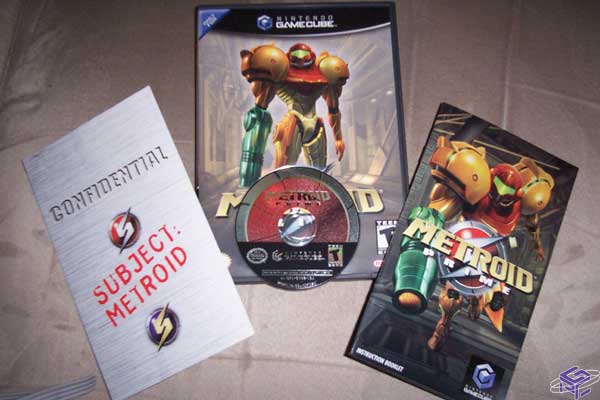Metroid Prime is just that, a prime-cut of gaming goodness ...
First off, let me just say that Metroid Prime is the most amazing game I’ve ever played. I’m quite literally sitting here slack-jawed as I play the game, amazed at the ridiculous level of detail Retro Studios has coated this game with. This may sound like fanboyish gushing, but I’m not even close to overstating how wonderful this game is. The best part is that the story is delivered entirely through visual cues and scanning of objects around you. You can make the story as detailed or loose as you want. Everything you do decide to scan goes into a log book that you can check out from the inventory menu at any time.
Metroid Prime comes with both an Instruction Booklet and a “Confidential” document which explains how to play the NES version of Metroid (see below).

The game starts you off at the space station above Tallon IV, just like in the demo, but contrary to reports online, it is NOT exactly the same as before. Several changes were made, including some that would be considered spoiler material, namely the addition of the three-dimensional map. You also find out that despite what the demo would have you believe, Samus destroying the Parasite Queen in the demo is NOT what starts the chain reaction that destroys the space station. Retro has cleverly kept that little detail hidden so that it makes a bigger impact when you play the game. And WHAT an impact! Since it’s a minor spoiler, I’m going to hide it here, so that the curious can read it. It’s in the first 10 minutes of gameplay, so I wouldn’t really say that it spoils much. Drag your mouse down from here to reveal it.
As you’re escaping the space station, you come face to face with a winged bird/dragon creature that looks suspiciously like our old friend Ridley. He flies off, and Samus manages to escape just in time to follow him to the planet’s surface. Before she escapes, an electrical charge damages Samus’s suit, causing her to lose all of her weapons and the Varia suit.
The game starts in earnest once you hit the surface of Tallon IV. From here, despite the 3D, first-person perspective, the game is pure Metroid. Well, Metroid, plus a raft of new features. The Scan Visor is fabulous, giving you great hints on how to beat enemies and general backstory into the game. You’ll be using it to find places to bomb, activate runes or switches, and just explore your surroundings visually. The Log Book is amazingly detailed and gives this one of the richest stories in a game that I can remember. Being able to zoom in on Samus in the Inventory screen and check her out in all her 3D glory is great, especially after a suit upgrade.
While the game lacks any significant voice acting, whoever they tapped to do Samus’ bloodcurdling scream when she dies needs a bonus. In fact, the sounds of the game are all-around amazing. The music is very reminiscent of the previous games in some places (albeit, updated and a little more “techno”), but some of the other music is incredibly deep and entrancing. And it all makes your heart race.
The game progresses in difficulty quickly, and I’ve found myself trying to figure out where to go on several occasions. Nintendo wasn’t kidding when they said that this is a “first person adventure”, because while you do a fair amount of shooting, there is a ton of exploring to do. You’re aided by a terrific 3D map that updates as you find new areas, assisted by map upgrades along the way. Still, there’s always a way to get to new areas, and sometimes it’s as simple as seeing a door on the map that you haven’t yet found a way to.
So far, it seems like all the standard items are here, Morph Ball, Missiles, Energy Tanks, etc. A nice touch is the way charging the Charge Beam creates a little “gravity well” and sucks in nearby energy balls or missiles. The game is full of little details like that. Other examples include the way rain bounces off Samus’s gun, or the way little heat ripples rise from the barrel if you’ve been shooting a lot. For kicks, drop a bomb in a pool of water, and watch what happens. And of course, by now you’ve all heard about the much vaunted visor effects. But my favorite so far is the animation you get when you recover your Varia suit. Man alive, that was simple and yet very impressive. It’s insane just how much they’ve put in that serves no functional purpose, but adds so much atmosphere that the game would be less entertaining without it.
Speaking of which, as soon as you start your game, you’ll be fully aware of some of the treats that await you. On the Main Menu, there is a listing for Metroid Fusion Connection Bonuses. When you complete Metroid Fusion, connect it to Prime to unlock the NES version of Metroid. Complete Prime, and connect it to Fusion to use the Fusion suit within Prime. (Yes, this is backwards from what we were originally told, but I’m going to trust that the game is correct.) Secondly, there is an “Image Gallery” which cannot be accessed, but I’m sure it’s a bonus you get depending on completion percentage and time elapsed.
Rest assured that if you have the game on pre-order, your money is not misplaced. And anyone who doesn’t plan on getting Metroid Prime as soon as possible really needs to have their head examined. Prime is easily the best game released on GameCube yet, which makes the pair of Prime and Fusion really unique in their own right.
 preview
preview